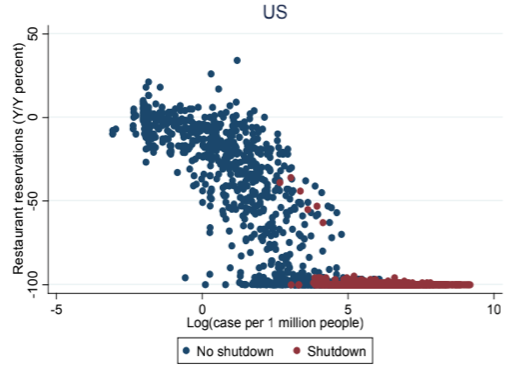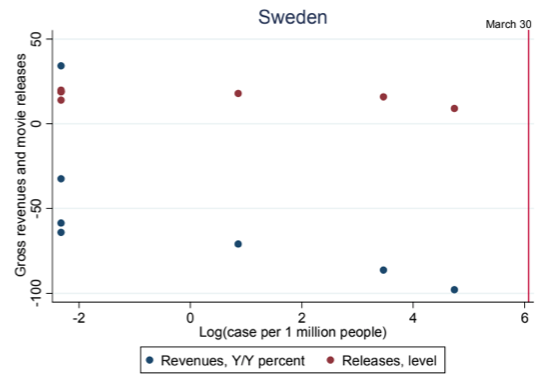Reducing interactions among people is seen as critical to reducing propagation of COVID-19 (e.g. Baldwin and Weder di Mauro 2020). A variety of Non-Pharmaceutical Interventions (NPIs), such as closure of non-essential businesses, stay at home orders, or school closings have been put in place to accomplish this, with apparent success in advanced countries (e.g. Hartle et al. 2020).
While there is controversy around whether this should be the goal in developing countries as well (Barnett-Howell and Mobarak 2020, Loayza 2020, Subramanian and Vandewalle 2020), there is also concern about whether such measures would even work. Governments’ abilities to enforce such measures may be weaker, and resistance higher, since the trade-off with livelihoods is harsher.
At the other extreme of the cycle - where the debate is when to loosen NPIs, as it is in several advanced countries – preliminary evidence from Wuhan suggests that when opened, mobility and economic activity may not respond quickly.
At the other extreme of the cycle - where the debate is when to loosen NPIs, as it is in several advance countries – preliminary evidence from Wuhan suggests that when opened, mobility and economic activity may not respond quickly … As Crosby (2003) notes, during the 1918 Influenza epidemic in San Francisco, “Fear had been the enforcer of the Board of Health’s policies”, not the authorities themselves.
Hence, it is important to understand the determinants of social distancing and mobility.
The determinants of social distancing and reduced mobility
In this column we argue that while NPIs have played an important role, the dominant driver in reducing mobility and economic activity has been self-regulation on a large part of the population. As Crosby (2003) notes, during the 1918 Influenza epidemic in San Francisco, “Fear had been the enforcer of the Board of Health’s policies”, not the authorities themselves.
This suggests that significant social distancing will happen regardless of the presence of NPIs. Further, viewed through this lens, restrictions may function more like a coordinating device among increasingly predisposed individuals than repressive measures per se – if we’re all working from home, then I won’t be viewed badly for doing so. Whether schools are online or in-person requires a decision that individual concerned parents cannot control. Clearly, for those not inclined to demobilize, NPIs play their traditional role.
The US case
Figure 1 plots Google data on mobility derived from the Maps smart-phone application, explicitly provided as a measure of social distancing, against the log of case incidence per capita by US state. It further divides the sample by whether states are covered by restrictions on non-essential businesses (red) or not (blue). The data are consistent with restrictions leading to lower levels of mobility. More striking is the clear downward-sloping relationship between reported cases and mobility independent of such restrictions, suggesting that individuals are taking self-protective measures in response to an increased perception of risk.
Figure 1 Mobility, COVID cases and official restrictions, US
Notes: Workplace mobility is a Google measure of work-related mobility index.
Formal estimations suggest that both effects are at work. However, of the roughly 60-point decline in mobility, fewer than five points appear due to closure of non-essential businesses, fewer than 20 for all NPIs, while national and local case incidence accounts for 2/3.
The data are consistent with restrictions leading to lower levels of mobility. More striking is the clear downward-sloping relationship between reported cases and mobility independent of such restrictions, suggesting that individuals are taking self-protective measures in response to an increased perception of risk.
Global evidence
Figures 2 plot the same sub-national relationship for six countries of potential interest: Italy, Japan, Sweden, and the UK, as well as two upper middle-income countries, Brazil and South Africa, for which we have reasonable smart phone coverage. In every case, the figures show strong evidence of decreased mobility with the increase in case incidence. In formal estimations, three findings emerge. First, in Brazil, Italy, South Africa, Sweden, and the UK, the semi-elasticities of mobility with respect to case incidence are comparable to those found in the US, while Japan’s is much lower. Second, NPIs have large effects in Italy, South Africa, and the UK. For Brazil, Italy, South Africa, Sweden, and the UK, however, the ‘voluntary’ component still contributes the largest share. In Sweden, mobility falls 60 points, or almost that seen in the US (the extreme 80 point falls are due to the 10 April long holiday weekend). Hence, the sharp contrast often depicted between Sweden and more interventionist countries appears overrated; mobility has fallen drastically and of similar magnitudes.
Japan’s relative low responsiveness to case incidence presents something of a puzzle given that it is also a country with an informed populace, effective governance, and high social capital. One explanation lies precisely in the importance of NPIs as coordination mechanisms. The tepid measures of the 7 April State of Emergency faced strong headwinds in the form of other social norms, such as a work culture in which employees fear being seen as slackers if they don’t appear for work in person. Unless everyone is sent home, everyone goes to work. The lack of a stronger coordination mechanism through official measures is a plausible explanation for both for the insignificant impact of formal measures and the limited amount of self-motivated reductions in mobility.
Figure 2 Workplace mobility vs. cases and closure of non-essential businesses: Selected countries
Notes: Workplace mobility is Google measure of work-related mobility index.
Figure 3a provides the analogous graphs for a global panel of countries divided into Low Income Countries (LIC), Lower Middle Income (LMIC), Upper Middle Income (UMIC) and High Income (HIC), but as yet no NPIs. Figure 3b is the same, but only includes country-periods when official restrictions on non-essential businesses are in place. In both cases, the downward slope with respect to incidence appears across all income categories. Formal estimations confirm previous findings. The effect of increased COVID incidence on mobility is both of larger magnitude than in the US and very similar across LMICs and HICs. Finding no effect in LICs is consistent with the argument that in very poor countries, people cannot afford not to work and hence will continue to do so.
Figure 3 Mobility, COVID cases and NPIs, global sample
Notes: Workplace mobility is Google measure of work-related mobility index. LIC, LMIC, UMIC, and HIC stand for Low Income Countries, Lower Middle-Income Countries, Upper Middle-Income Countries, and High Income Countries, respectively.
The impact of NPIs themselves is mixed and often large, but remains less important than the voluntary component in all but the LICs. Workplace closures, school closing, and restrictions on internal mobility are all significant, accounting for nearly nine points of reduced mobility in LMICs. This suggests that governments in even moderately poor countries are able to deliberately effect a slowdown. In LICs, the only NPI that appears to have any effect is closing public transportation, suggesting greater resistance/weaker enforcement of less drastic measures. The weaker self-demobilizing effect in LICs may also suggest, more generally, that the impact of enforcing NPIs bites disproportionately on poorer people.
Mapping to economic activity
Do these voluntary declines in Google mobility in fact map on to economic activity? Preliminary evidence from the US and Sweden suggests they do. Figure 4 plots restaurant reservations by state against COVID incidence for the US. It finds that the fall in reservations predated the closing of non-essential businesses and shows virtually no impact of business closing measures. In the same vein, Figure 5 presents national data from movie theatre releases and revenues in Sweden, a country that imposed suggested non-essential business closings and banned 50+ meetings relatively late, on 30 March. Long before this date, movie revenues (demand) dropped off entirely while releases (supply) continued more or less unchanged. The results again suggest that what slowed economic activity was not the NPIs, but rather increased self-enforced demobilization as evidence of the magnitude of the threat accumulated.
Figure 4 Decline in restaurant reservations vs COVID cases
Figure 5 Decline in movie theatre revenues and releases vs COVID cases
Notes: US Restaurant reservations against COVID incidence. Sweden: Movie releases and theatre revenues against COVID incidence. See text for sources.
Conclusion
These findings offer both good and bad news.
On the good side, they imply that for many countries in the world, self-enforcing dynamics and NPIs can reduce mobility substantially without much state capacity.
That mobility fell almost as much in Sweden, with no NPIs, as in the US dramatically illustrates this point. Further, given the increasing predisposition of the populace as risk rises, NPIs may serve as much as coordinating devices than as repressive measures. The poorest countries appear to be the exception to this pattern; the finding that only shutting down public transport has any effect is consistent with arguments that government capacity may be generally low, and resistance to demobilizing high, where it implies lost livelihoods. This also points to the fact that those who voluntarily demobilize may be those who are better off, and the NPIs may wind up biting more on those who can’t afford not to work. More generally, the finding of a large voluntary demobilization says nothing about whether such mobilization is enough and, indeed, NPIs may be necessary to reach socially optimal levels.
On the bad side, the results suggest that releasing constraints may not have the expected economically rejuvenating effect.
If the populace is not convinced that ‘the coast is clear’, then continued uncertainty is more likely to dictate a longer recovery period.
References
Baldwin, R and B Weder di Mauro, eds (2020b), Mitigating the COVID economic crisis: Act fast and do whatever it takes, a VoxEU.org eBook, 18 March.
Barnett-Howell, Z and A M Mobarak (2020), “Should Low-Income Countries Impose the Same Social Distancing Guidelines as Europe and North America to Halt the Spread of COVID-19?”, Yale School of Management and Y-RISE.
Crosby, A W (2003), America’s Forgotten Pandemic: The Influenza of 1918. Cambridge University Press.
Hartl, T, K Wälde and E Weber (2020), “Measuring the impact of the German public shutdown on the spread of COVID-19”, VoxEU.org, 14 April.
Loayza, N (2020), “Costs and Trade-Offs in the Fight against COVID-19”, World Bank.
Maloney, W F and T Taskin (2020), “Social Distancing and Economic Activity during COVID-19: A Global View”, COVID Economics Issue 13, 4 May.
Ray, D, S Subramanian and L Vandewalle (2020), “India's lockdown”, VoxEU.org, 08 April.





